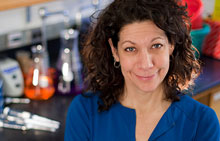Main Content
Shaw Prize for Quorum Sensing

Bonnie Bassler, Princeton University. Credit: Zach Donnell.
The Shaw Prize Foundation in Hong Kong announced today that Bonnie Bassler, a Howard Hughes Medical Institute investigator at Princeton University, has been awarded the Shaw Prize in Life Science and Medicine.
Bassler shares the $1 million award with E. Peter Greenberg of the University of Washington. The two were honored for their discovery of quorum sensing, a process whereby bacteria communicate with each other and which may offer innovative ways to interfere with bacterial pathogens or to modulate the microbiome for health applications.
The Shaw Prize consists of three annual awards in astronomy, life science and medicine, and mathematical sciences. These international awards honor individuals who have achieved significant breakthroughs in academic and scientific research. The awards are dedicated to furthering societal progress, enhancing quality of life, and enriching humanity’s spiritual civilization. The 2015 prizes will be presented to recipients later this year at a ceremony in Hong Kong.
Until recently, the ability of bacteria to communicate with one another was considered an anomaly that occurred only among a few marine bacteria. It is now clear that group talk is the norm in the bacterial world, and understanding this process is important for fighting deadly strains of bacteria and for understanding communication between cells in the human body.
Bonnie Bassler describes traits that make a good scientist. Credit: HHMI BioInteractive.
Bassler has discovered that bacteria communicate with a chemical language. This process, called quorum sensing, allows bacteria to count their numbers, determine when they have reached a critical mass, and then change their behavior in unison to carry out processes that require many cells acting together to be effective.
For example, one process commonly controlled by quorum sensing is virulence. Virulent bacteria do not want to begin secreting toxins too soon, or the host’s immune system will quickly eliminate the nascent infection. Instead, Bassler explains, using quorum sensing, the bacteria count themselves and when they reach a sufficiently high number, they all launch their attack simultaneously. This way, the bacteria are more likely to overpower the immune system. Quorum sensing, Bassler says, allows bacteria to act like enormous multicellular organisms. She has shown that this same basic mechanism of communication exists in some of the world’s most virulent microbes, including those responsible for cholera and plague.
Working with Vibrio harveyi, a harmless marine bacterium that glows in the dark, Bassler and her colleagues discovered that this bacterium communicates with multiple chemical signaling molecules called autoinducers (AIs). Some of these molecules allow V. harveyi to talk to its own kind, while one molecule – called AI-2 – allows the bacterium to talk to other bacterial species in its vicinity. Bassler showed that a gene called luxS is required for production of AI-2, and that hundreds of species of bacteria have this gene and use AI-2 to communicate. This work suggests that bacteria have a universal chemical language, a type of “bacterial Esperanto” that they use to talk between species.
Her research opens up the possibility for new strategies for combating important world health problems. Her team is currently working to find ways to disrupt the LuxS/AI-2 discourse so the bacteria either cannot talk or cannot listen to one another. Such strategies have potential use as new antimicrobial therapies.
